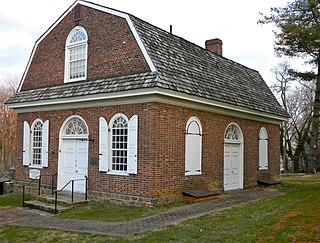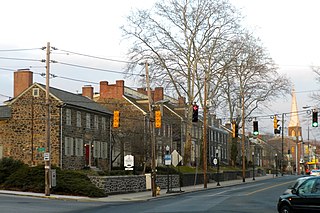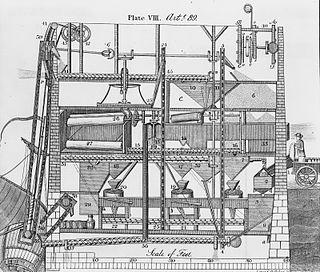
The Hagley Museum and Library is a nonprofit educational institution in unincorporated New Castle County, Delaware, near Wilmington. Covering more than 235 acres (95 ha) along the banks of the Brandywine Creek, the museum and grounds include the first du Pont family home and garden in the United States, the powder yards, and a 19th-century machine shop. On the hillside below the mansion lies a Renaissance Revival garden, with terraces and statuary, created in the 1920s by Louise Evelina du Pont Crowninshield (1877–1958).

Brandywine Creek is a tributary of the Christina River in southeastern Pennsylvania and northern Delaware in the United States. The Lower Brandywine is 20.4 miles (32.8 km) long and is a designated Pennsylvania Scenic River with several tributary streams. The East Branch and West Branch of the creek originate within 2 miles (3 km) of each other on the slopes of Welsh Mountain in Honey Brook Township, Pennsylvania, about 20 miles (32 km) northwest of their confluence.

The Jacob Broom House, also known historically as Hagley, is a historic house on Christchurch Road near Montchanin, Delaware. It was built in 1795 by Founding Father Jacob Broom, one of the Delaware signers of the United States Constitution. The house was purchased in 1802 by Éleuthère Irénée du Pont, progenitor of the prominent Du Pont family and founder of the DuPont chemical concern, who established the Eleutherian Mills below the house on the banks of Brandywine Creek. The house, which remains in the hands of Du Pont descendants, was declared a National Historic Landmark in 1974 for its association with Broom.

From 1802 to 1921, Eleutherian Mills was a gunpowder mill site used for the manufacture of explosives founded by Eleuthère Irénée du Pont, which grew into the DuPont company. The name also refers to the house on the hill above the mills, which was the first du Pont family home in America. In 1957 the site became an outdoor museum when the Hagley Museum and Library was founded. The site was declared a National Historic Landmark in 1966.

The Delaware Historical Society began in 1864 as an effort to preserve documents from the Civil War. Since then, it has expanded into a statewide historical institution with several buildings, including Old Town Hall and the Delaware History Museum, in Wilmington and the historic Read House & Gardens in New Castle.
Edenridge is an unincorporated community in New Castle County, Delaware, United States in the Brandywine Hundred, north of Wilmington.

Woodbrook is a suburban community in New Castle County, Delaware.

District Number 7 School, also known as Speedsville School, is a historic one room school building located at Speedsville in Tompkins County, New York, U.S.A. It was built about 1850 and is a one-story, 30 feet wide by 50 feet deep, frame structure. The building was used as a school until 1956 and is now a Sunday school and community center for the adjacent St. John's Episcopal Church.

Old First Presbyterian Church of Wilmington is a historic Presbyterian church located on West Street on Brandywine Park Drive in Wilmington, New Castle County, Delaware.
Brandywine Avenue School was a historic school located at Schenectady in Schenectady County, New York. It was built in 1904 and was a 3+1⁄2-story, red brick "U" shaped institutional building in the Classical Revival style. It sat on a basement of rock-faced limestone and had a hipped roof. It operated as a teacher training facility from 1910 to 1925 and ceased being used as a school in 1974. From 1975 to 1996, it housed Schenectady City School District administrative offices and records storage.

William Young House is a historic home located near Rockland, New Castle County, Delaware. The house was added to the National Register of Historic Places in 1982.

Walker's Mill and Walker's Bank, also known as Simsville, Siddall's Mill, and "Big White Mill", is a historic spinning cotton mill and worker's dwelling block located near Wilmington, New Castle County, Delaware. Walker's Mill was built between 1813 and 1815, and is a 2+1⁄2-story, "T"-shaped, stone building.

P. S. Dupont High School is a historic high school building located at Wilmington, New Castle County, Delaware. It was built in 1934, and is a four-story, "E"-shaped, red brick building in a Colonial Revival / Neo-Georgian style. It has a hipped roof covered with dark reddish-brown shingles, topped by a wood, three-level tower and cupola that ends in a multiple-sided, bell-like copper roof and weather vane. The school is named for Pierre S. du Pont (1870–1954).

New Castle Leather Raw Stock Warehouse, also known as the Kaumagraph Building, is a historic warehouse building located at Wilmington, New Castle County, Delaware. It was built in 1917, and is a three-story, rectangular steel, concrete, and brick building measuring 100 feet by 200 feet and featuring a projecting roof cornice, flat roof, and large window areas. It is characterized as a fireproof industrial building in the commercial style of the early 1900s. It was originally built as a warehouse to store goatskins for a Wilmington kid leather manufacturer and later housed the plant and offices of a specialty printing firm.

Augustine Paper Mill, also known as the Container Corporation of America, Paper Mill Division, was a historic paper mill complex located in Wilmington, New Castle County, Delaware. The complex consisted of seven 19th century stone buildings including the original three-story mill building, also known as Building 7, and various later two-level mill structures and support buildings. As of 2022, Building 7 is the only surviving part of the complex. It is a three-story mill erected from randomly laid stone with walls three feet thick, a slate covered gable roof, and an arched brick opening for the mill race.

Brandywine Village Historic District is a national historic district located along Brandywine Creek at Wilmington, New Castle County, Delaware. It encompasses 12 contributing buildings, 7 contributing sites, and 2 contributing structures. Brandywine Village developed in the late-18th century as a group of flour mills, the homes of prosperous millers, mill workers, shop keepers and artisans. Located in the district are a set of mill owner built homes of granite. Notable buildings include the Gothic Revival style St. John's Episcopal Church (1857-1858) designed by noted Philadelphia architect John Notman, Brandywine Methodist Episcopal Church (1857), and Brandywine Academy (1798). In 1788, Brandywine Village was the site of the first mechanized mill designed by Oliver Evans.

Breck's Mill Area, also known as Breck's Mill Area-Henry Clay Village Historic District, is a national historic district located along Brandywine Creek in unincorporated New Castle County, Delaware, near Wilmington. It encompasses 56 contributing buildings, five contributing sites, and three contributing structures. The district encompasses The Mill, The Workers' houses, and The Mill Owner's Home.

Brandywine Village was an early center of U.S. industrialization located on the Brandywine River in what is now Wilmington, Delaware.

The Wallace Farm is a historic farm within Cuyahoga Valley National Park in Summit County, Ohio. The property overlooks Brandywine Falls, a 63 feet (19 m) waterfall on Brandywine Creek. Land speculator and sawyer George Wallace settled on the land with his family in the 1810s; Wallace helped found the nearby village of Brandywine and became its first postmaster in 1825. His sons James and George Y. Wallace began farming on the land in the 1830s, though George Y. died in the 1840s. James built a farmhouse and barn on the farm circa 1850, both of which are still standing. The farmhouse has a Greek Revival design with a gable roof and six-over-six double-hung sash windows. The farm also includes a twentieth-century concrete workshop, the ruins of the sawmill, and several building foundations.





















